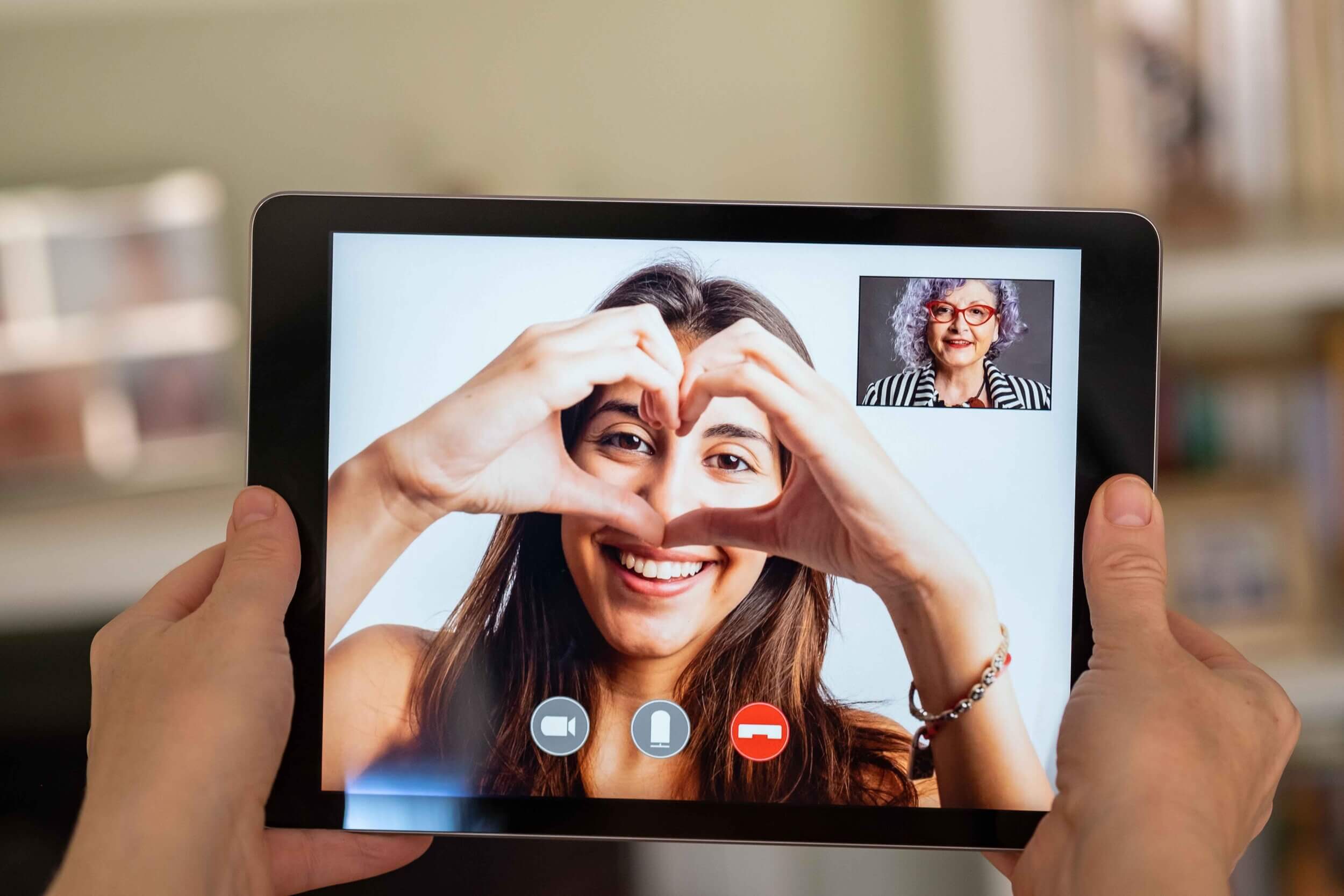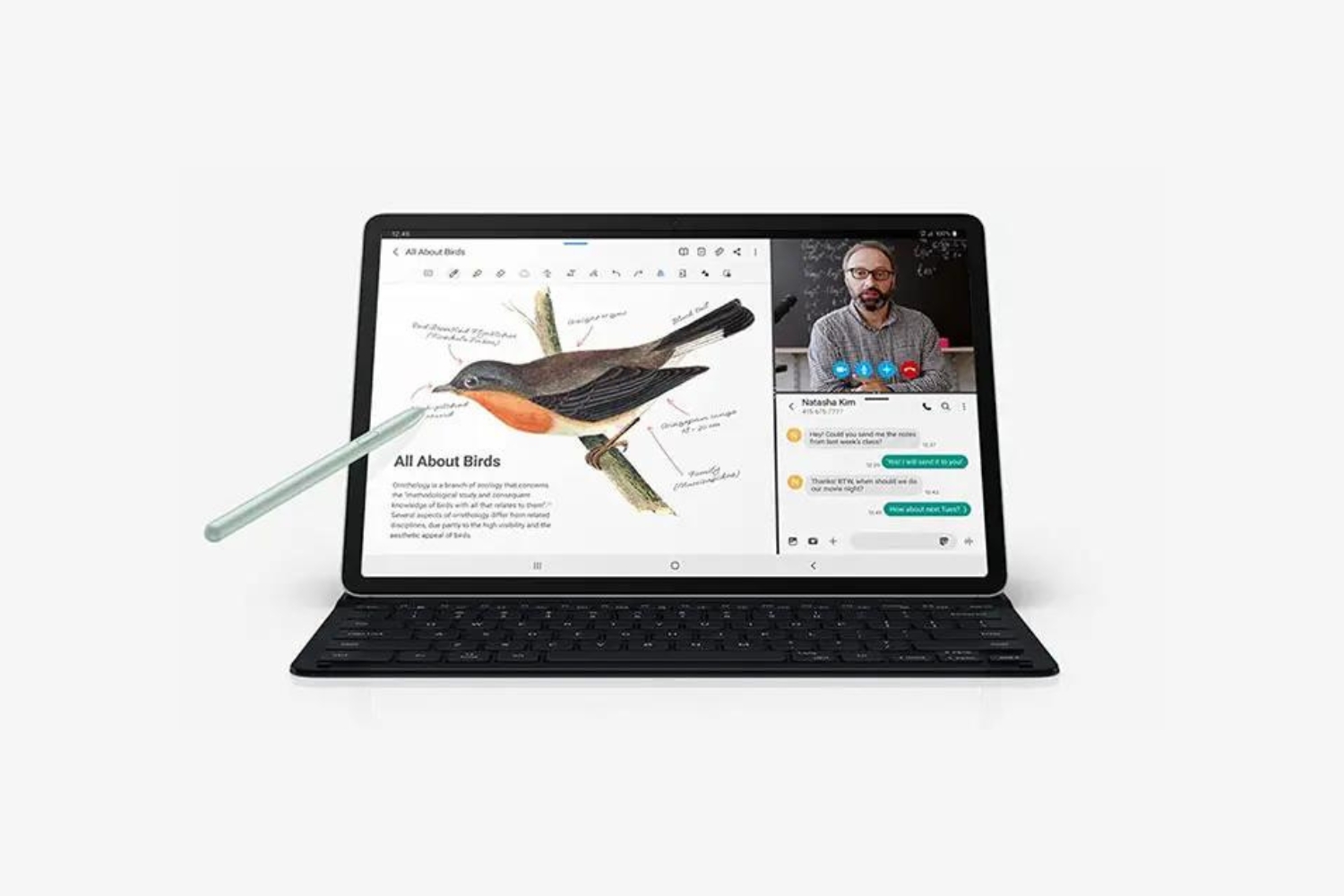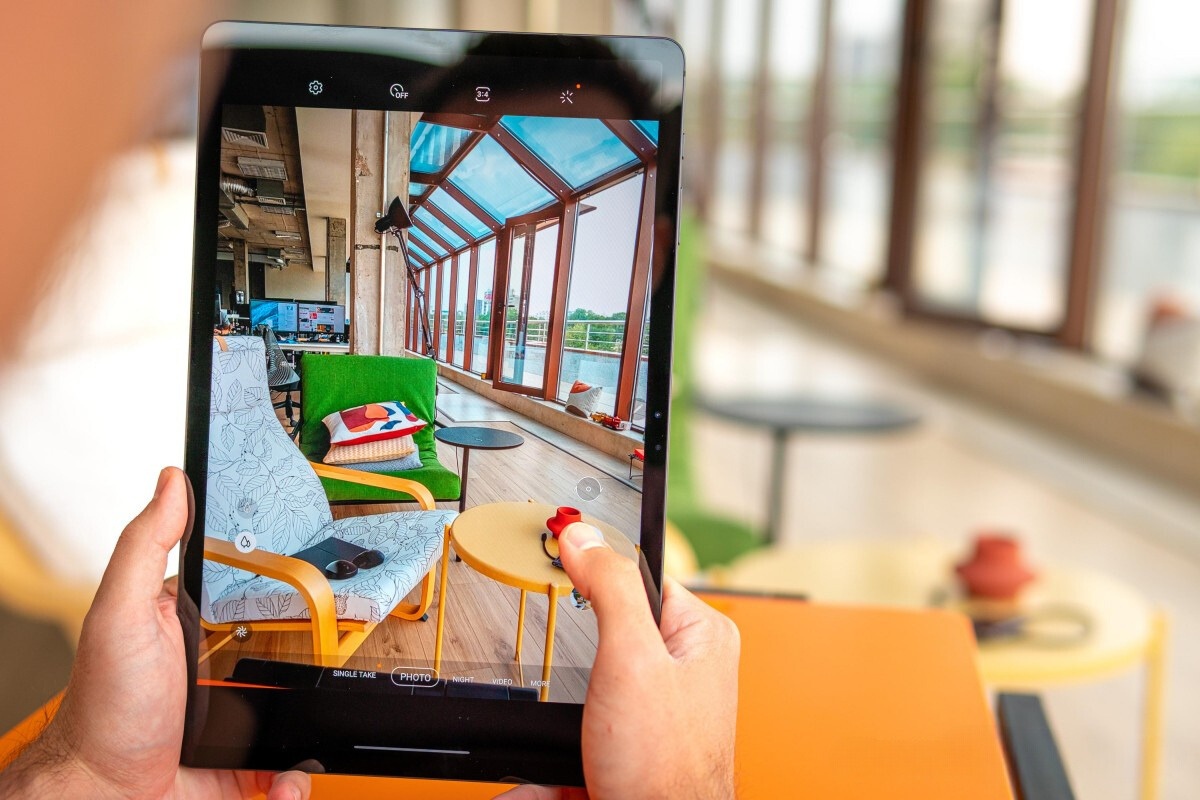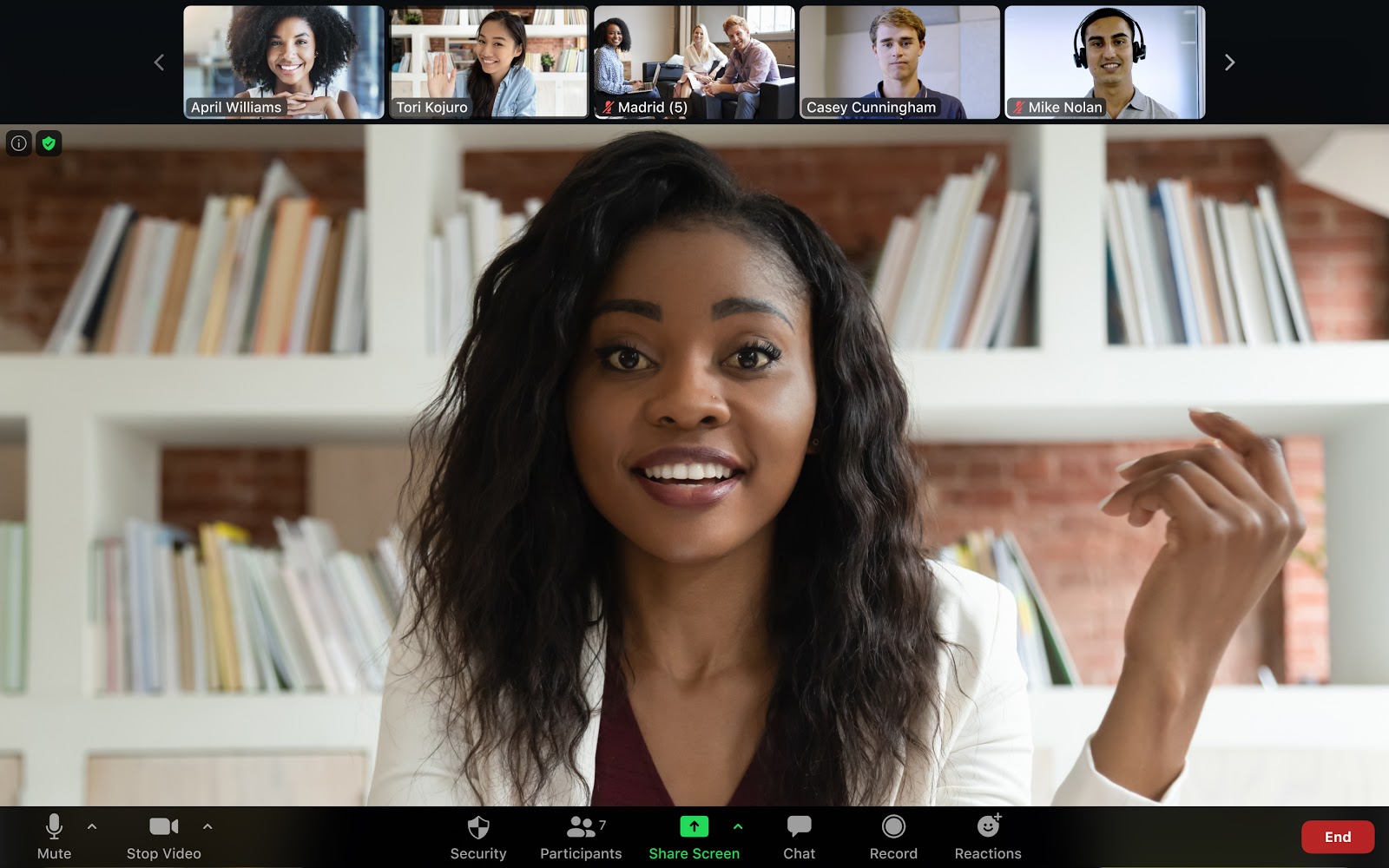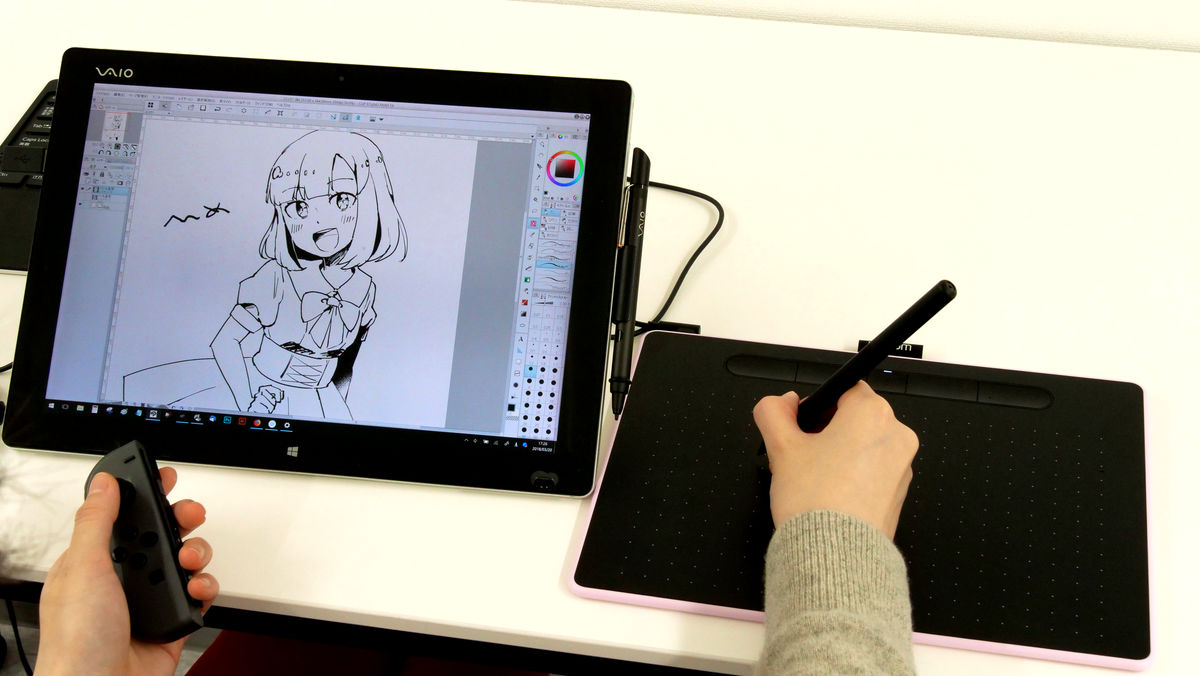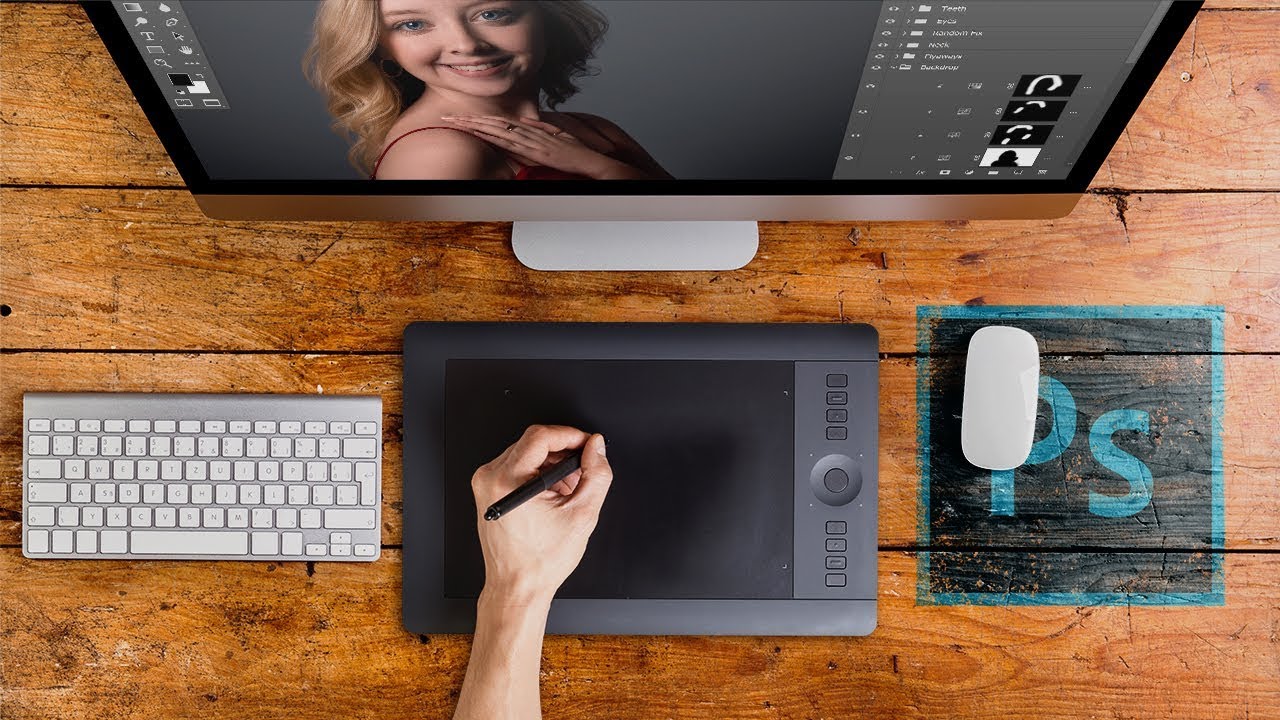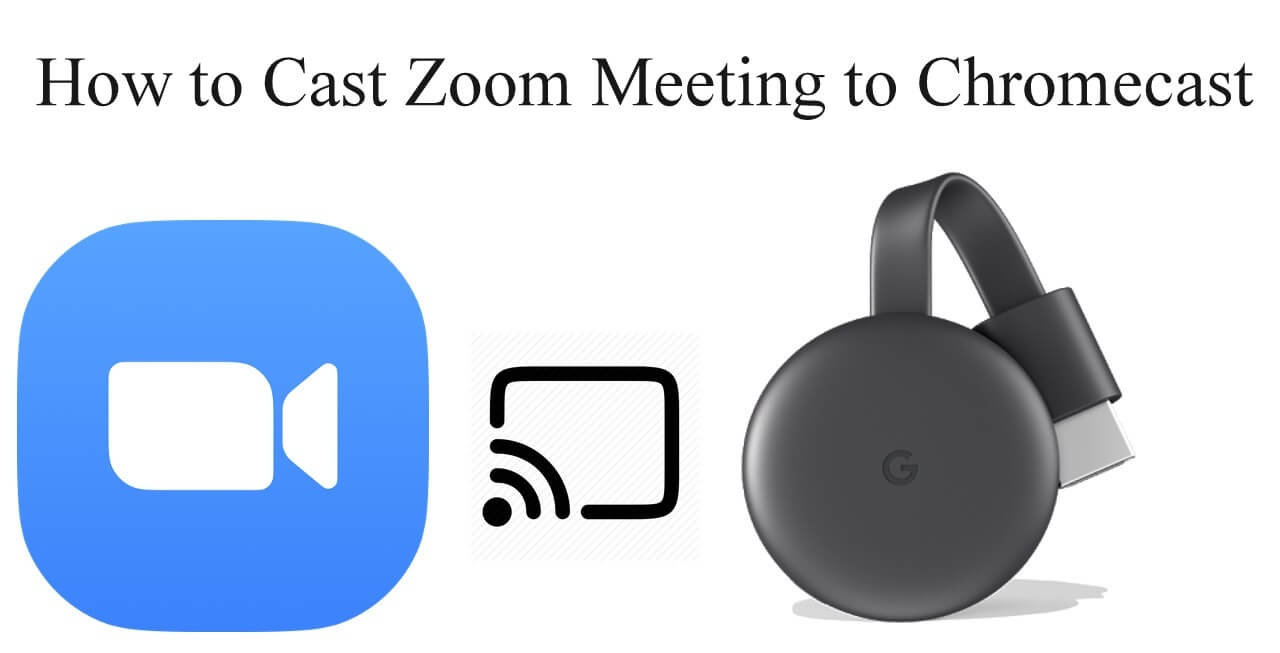Introduction
Welcome to the world of Zoom! With the increasing need for remote communication and collaboration, Zoom has become a ubiquitous tool for online meetings, webinars, and virtual classrooms. Whether you’re a student attending classes from home or a professional joining meetings on the go, using Zoom on your tablet is a convenient way to stay connected.
In this guide, we will walk you through the process of using Zoom on your tablet, from downloading and installing the app to hosting and joining meetings. We’ll explore various features and settings that will help you make the most out of your Zoom experience on a tablet. So, let’s get started!
Before we dive into the details, it’s important to note that Zoom is available for both iOS and Android tablets. The user interface may vary slightly depending on your device, but the overall functionality remains consistent.
Whether you’re a first-time Zoom user or looking to enhance your knowledge, this guide will provide you with step-by-step instructions, tips, and tricks to ensure a seamless Zoom experience on your tablet.
While there may be other video conferencing platforms available, Zoom has gained immense popularity due to its user-friendly interface, reliability, and array of features. From virtual backgrounds to screen sharing capabilities, Zoom offers a comprehensive platform for all your communication needs. So, let’s delve into the world of Zoom on tablets and explore its functionalities in detail.
Downloading and Installing Zoom
Before you can start using Zoom on your tablet, you’ll need to download and install the Zoom app. Follow these steps to get started:
- Open the App Store (iOS) or Play Store (Android) on your tablet.
- Type “Zoom” in the search bar and tap on the Zoom app.
- Tap the “Install” button to download the app.
- Once the app is installed, tap on the Zoom icon to launch the app.
- You will be greeted with the login screen. If you already have a Zoom account, enter your credentials and tap “Sign In”. If you don’t have an account yet, proceed to step 6.
- Tap on the “Sign Up” button to create a new Zoom account.
- Enter your email address and password, then tap “Sign Up”. You can also sign up using your Google or Facebook account if you prefer.
- Check your email for a verification message from Zoom and follow the instructions to verify your account.
- Once your account is verified, relaunch the Zoom app and sign in using your newly created credentials.
That’s it! You have successfully downloaded and installed Zoom on your tablet. Now you can proceed to the next section to learn how to create a Zoom account.
It’s worth mentioning that Zoom updates its app regularly to improve performance and introduce new features. To ensure you have the latest version, enable automatic app updates on your tablet or periodically check for updates in the App Store (iOS) or Play Store (Android).
Throughout this guide, we’ll be focusing on the Zoom mobile app specifically designed for tablets. However, you can also use Zoom on your tablet’s web browser by visiting the Zoom website and logging in to your account. The mobile app offers a more optimized and user-friendly experience, so we recommend using it whenever possible.
Creating a Zoom Account
Before you can start using Zoom on your tablet, you’ll need to create a Zoom account. Follow these steps to get started:
- Open the Zoom app on your tablet.
- On the login screen, tap on the “Sign Up” button.
- Enter your email address and password in the provided fields. Make sure to use a strong and secure password.
- Tap on the “Sign Up” button to proceed.
- Check your email for a verification message from Zoom.
- Open the email and click on the verification link provided.
- Once your account is verified, you’ll be redirected to the Zoom app.
- On the next screen, enter your first name, last name, and choose a display name.
- You can also choose to upload a profile picture by tapping on the profile icon.
- Tap on the “Continue” button to complete the account setup process.
Congratulations! You have successfully created a Zoom account. Now you can start using Zoom on your tablet to join and host meetings, collaborate with colleagues, and connect with friends and family.
It is important to note that you can sign up for a Zoom account using your email address or by linking your Google or Facebook account. This provides you with different options for creating and accessing your Zoom account conveniently.
Once you have created your Zoom account, you can also customize your profile settings, such as your profile picture, display name, and notification preferences. These settings can be accessed by tapping on the profile icon in the Zoom app and selecting “Settings”. Explore these options and make adjustments according to your preferences.
Now that you have a Zoom account, let’s move on to the next section where we will learn how to access Zoom on your tablet.
Accessing Zoom on your Tablet
Now that you have downloaded and installed Zoom and created a Zoom account, it’s time to access the app on your tablet. Here’s how:
- Locate the Zoom app icon on your tablet’s home screen or app drawer.
- Tap on the Zoom icon to launch the app.
- On the login screen, enter your Zoom credentials (email address and password) and tap “Sign In”.
- If you have enabled the “Remember me” option, you will be logged in automatically without having to enter your credentials each time you launch the app.
- Once you’re logged in, you will be greeted with the Zoom home screen on your tablet.
- The home screen provides quick access to your upcoming meetings, calendar integration, and other useful features.
- Tap on the “Meet & Chat” tab at the bottom of the screen to access your meetings and chat conversations.
- To join a meeting or start a new meeting, tap on the respective buttons on the home screen or navigate to the “Meet & Chat” tab.
Additionally, you can also access Zoom through your tablet’s notification bar. When you receive an invitation or meeting reminder, simply tap on the Zoom notification to directly join the meeting. This provides a convenient way to access Zoom on the go and swiftly join your scheduled meetings.
Zoom also offers widget support for tablets. By adding the Zoom widget to your tablet’s home screen, you can quickly view your upcoming meetings or start a new meeting with just a single tap. To add the Zoom widget, long-press on an empty space on your tablet’s home screen, select “Widgets”, find the Zoom widget, and drag it to your desired location on the home screen.
Now that you know how to access Zoom on your tablet, let’s move on to the next section where we’ll explore how to join a meeting using Zoom.
Joining a Meeting
One of the primary purposes of using Zoom on your tablet is to join online meetings. Whether it’s a work meeting, a virtual classroom, or a social gathering, Zoom makes it easy to connect with others. Here’s how to join a meeting using Zoom on your tablet:
- Open the Zoom app on your tablet.
- If you’re not already logged in, enter your Zoom credentials (email address and password) and tap “Sign In”.
- On the Zoom home screen, tap the “Join” button.
- Enter the Meeting ID provided by the meeting host. You can also enter a personal meeting link if you have been given one.
- Optionally, you can enter a display name that will be visible to others in the meeting.
- Choose whether to join with audio and video enabled or disabled. You can always enable or disable these options later once you’re in the meeting.
- Tap the “Join Meeting” button to join the meeting.
- If the meeting hasn’t started yet, you will see a waiting screen until the host initiates the meeting.
- Once you’re in the meeting, you can use various features like video, audio, chat, screen sharing, and more, depending on the host’s settings.
If you have received an invitation or meeting link via email or another communication channel, you can also join a meeting directly from the link. Simply tap on the meeting link, and it will automatically open the Zoom app and prompt you to join the meeting.
If a meeting requires a password, ensure you enter the correct password provided by the host to join the meeting successfully. Meeting passwords add an extra layer of security to ensure only authorized participants can join.
Joining a meeting on your tablet allows you the flexibility to participate in conversations, collaborate on shared documents, and engage with other participants from the comfort of your device. Now that you know how to join a meeting using Zoom on your tablet, let’s move on to the next section where we’ll learn how to host a meeting.
Hosting a Meeting
As a Zoom user, you have the ability to host your own meetings and bring people together virtually on your tablet. Whether you’re conducting a business presentation, organizing a team meeting, or hosting a webinar, Zoom makes it easy to become the host. Here’s how to host a meeting using Zoom on your tablet:
- Open the Zoom app on your tablet.
- If you’re not already logged in, enter your Zoom credentials (email address and password) and tap “Sign In”.
- On the Zoom home screen, tap the “New Meeting” button.
- You will have the option to start the meeting with your video and audio enabled or disabled. Choose your preferred settings.
- Tap the “Start a Meeting” button to initiate the meeting.
- Once the meeting starts, your video will be displayed, and a toolbar will appear at the bottom of the screen with various options.
- Use the toolbar to manage your meeting, including controlling your audio and video settings, sharing your screen, accessing the chat function, and more.
- You can invite participants to the meeting by tapping on the “Participants” button on the toolbar and selecting the “Invite” option.
- A list of invitation methods will appear, such as sending an email invite or copying the meeting invitation link to share with others.
- Choose the desired method to invite participants and follow the instructions to send out the invitations.
- Throughout the meeting, you’ll have full control as the host, allowing you to manage participants, mute and unmute attendees, share files and presentations, and more.
As the host, you have the ability to customize the meeting settings according to your needs. You can adjust audio and video settings, enable or disable participant chat, control screen sharing permissions, and even enable virtual backgrounds to add a touch of creativity to your meetings.
Hosting a meeting on your tablet provides you with the convenience of leading discussions and collaborating with others, all from the palm of your hand. Now that you know how to host a meeting using Zoom on your tablet, let’s move on to the next section where we’ll explore how to adjust audio and video settings during a meeting.
Adjusting Audio and Video Settings
When attending or hosting a Zoom meeting on your tablet, it’s important to ensure that your audio and video settings are properly configured for a seamless communication experience. Here’s a guide on how to adjust audio and video settings using the Zoom app on your tablet:
- Open the Zoom app on your tablet and join or start a meeting.
- Once you’re in the meeting, look for the toolbar at the bottom of the screen.
- To adjust audio settings, tap on the “Audio” button.
- From here, you can choose the audio input and output devices, adjust the volume, and test your speakers and microphone.
- Make sure to select the correct audio devices to ensure clear audio transmission and reception during the meeting.
- To adjust video settings, tap on the “Video” button.
- Here, you can enable or disable your video camera, choose the video input source, and adjust the video resolution.
- Additionally, you can enable or disable the option to mirror your video display.
- Make sure to select the appropriate video input source if your tablet has multiple cameras.
- You can also test your video by tapping on the “Test Video” button and following the prompts.
Adjusting audio and video settings is crucial to ensure a smooth and professional meeting experience. It allows you to optimize the quality of your audio and video feed, reducing background noise and enhancing clarity.
If you encounter audio or video issues during a meeting, you can access the settings menu by tapping on the ellipsis (…) button on the toolbar and selecting “Settings”. From here, you can make further adjustments to your audio and video settings as needed.
Remember to test your audio and video settings before every meeting to ensure that you’re adequately prepared for a successful online interaction.
Now that you know how to adjust audio and video settings in Zoom on your tablet, let’s move on to the next section where we’ll explore how to share content during a meeting.
Sharing Content during a Meeting
One of the most valuable features of Zoom is the ability to share content with other participants during a meeting. Whether it’s a document, presentation, or a website, sharing content allows for effective collaboration and communication. Here’s how to share content during a Zoom meeting on your tablet:
- Join or host a meeting on your tablet using the Zoom app.
- Once you’re in the meeting, look for the toolbar at the bottom of the screen.
- To share your screen, tap on the “Share” button.
- A list of options will appear, showing the available content to share.
- Select the desired content you want to share, such as your entire screen or specific applications, documents, or webpages.
- Once you’ve made your selection, tap on the “Start Sharing” button to begin screen sharing.
- Participants in the meeting will now be able to see the shared content on their screens.
- To stop sharing, tap on the “Stop Share” button.
- If you’re the host, you also have the option to give control of your screen to another participant. To do this, tap on the “More” button and select “Allow Remote Control”.
- Participants can then interact with your shared screen and make annotations or adjustments if allowed.
In addition to screen sharing, Zoom also allows for sharing specific files or whiteboards. To share a file, tap on the “Share” button and select “Document” or “Presentation”. You can then browse through your tablet’s storage to select the file you want to share.
If you’re using Zoom’s whiteboard feature, you can tap on the “Whiteboard” option from the sharing menu. This allows you to draw, write, and make annotations on a blank canvas that can be shared with other participants.
Sharing content during a meeting on your tablet enhances collaboration and engagement among participants. It enables you to effectively convey information, gather feedback, and work on projects together in real-time.
Now that you know how to share content during a meeting using Zoom on your tablet, let’s move on to the next section where we’ll explore how to use the chat and emojis feature.
Using Chat and Emojis
Chat and emojis are valuable communication tools in Zoom that allow participants to communicate and express themselves during a meeting. Whether you want to share information, ask a question, or simply express your emotions, Zoom’s chat and emoji features are here to assist you. Here’s how to use chat and emojis in Zoom on your tablet:
- Join or host a meeting on your tablet using the Zoom app.
- Once you’re in the meeting, look for the toolbar at the bottom of the screen.
- To access the chat feature, tap on the “Chat” button.
- A chat panel will appear on the screen, displaying the conversation history and allowing you to send messages.
- To send a message, tap on the text field at the bottom of the chat panel, enter your message, and tap on the send button.
- You can send a message to the entire group or privately to a specific participant by selecting their name from the chat participants list.
- In addition to text messages, Zoom also allows you to send emojis to express yourself more visually.
- To access the emoji menu, tap on the smiley face icon next to the text field in the chat panel.
- A list of emojis will appear, categorized into different expressions and emotions.
- Select the desired emoji to send it in the chat.
- Participants in the meeting will be able to view and respond to chat messages and emojis accordingly.
The chat feature in Zoom is particularly useful for sharing links, providing clarifications, or engaging in side conversations without interrupting the main meeting flow.
Using emojis adds a touch of fun and expression to the conversation, allowing participants to convey their feelings and reactions in a visual and engaging manner.
It’s important to keep the chat and emoji usage in line with the meeting’s purpose and etiquette. Avoid using excessive emojis or spamming the chat, as it can distract and disrupt the meeting.
Now that you know how to use chat and emojis in Zoom on your tablet, let’s move on to the next section where we’ll explore Zoom’s whiteboard feature.
Utilizing Zoom’s Whiteboard Feature
Zoom’s whiteboard feature is a powerful tool that allows participants to collaborate and express their ideas visually during a meeting. Whether you’re brainstorming, illustrating concepts, or working on a creative project together, the whiteboard feature in Zoom on your tablet provides a versatile canvas for collaboration. Here’s how to utilize Zoom’s whiteboard feature:
- Join or host a meeting on your tablet using the Zoom app.
- Once you’re in the meeting, tap on the “Share” button at the bottom of the screen.
- From the share options, select “Whiteboard”.
- A whiteboard will appear on the screen, allowing you to draw and write on it.
- Use the drawing tools, such as pens and highlighters, to create your content.
- You can also select different colors and line thicknesses to customize your drawings.
- Additionally, there are options to clear the whiteboard, undo or redo your drawings, and save the whiteboard for future reference.
- To invite others to collaborate on the whiteboard, tap on the ellipsis (…) button on the top right corner and select “Invite” to send participants a link to join the whiteboard session.
- Participants can then contribute to the whiteboard by drawing, writing, or adding annotations.
- The whiteboard can be shared with all participants in real-time, fostering creativity and enhancing collaborative discussions.
- Once you’re finished with the whiteboard, you can save it as an image or PDF for future reference or sharing.
The whiteboard feature in Zoom provides a digital canvas where participants can brainstorm, visually explain concepts, and engage in interactive discussions. It’s particularly useful in educational settings, design reviews, or any scenario that demands visual collaboration.
Remember to communicate with your participants about the purpose and guidelines for using the whiteboard feature to ensure a productive and focused collaboration session.
Now that you know how to utilize Zoom’s whiteboard feature on your tablet, let’s move on to the next section where we’ll explore how to record meetings using Zoom.
Recording Meetings
Zoom provides a convenient feature that allows you to record your meetings directly on your tablet. Recording meetings can be beneficial for various reasons, such as reviewing discussions, sharing with absent participants, or referencing later. Here’s how to record meetings using Zoom on your tablet:
- Join or host a meeting on your tablet using the Zoom app.
- Once you’re in the meeting, look for the toolbar at the bottom of the screen.
- Tap on the “More” button (denoted by the ellipsis (…)) on the toolbar.
- From the options that appear, select “Record” or “Record Meeting”.
- A recording indicator will appear on the screen to indicate that the meeting is being recorded.
- During the meeting, Zoom will capture and record the audio, video, and shared content.
- To stop the recording, tap on the “More” button again and select “Stop Recording”.
- Once you stop the recording, Zoom will process the recording and save it to your device.
- You can access your recorded meetings in the “Recordings” tab within the Zoom app.
- From there, you can play, share, or delete your recorded meetings as needed.
Note that the ability to record meetings may require permission from the host if you’re a participant. As a host, you have full control over the recording feature and can decide whether to allow participants to record the meeting or restrict it to hosts only.
It’s essential to notify participants that the meeting is being recorded to ensure compliance with privacy and consent regulations. This can be done through a verbal announcement or by enabling the automatic notification feature in the Zoom settings.
Recording meetings on your tablet provides a valuable resource for future reference or sharing with others. It allows you to revisit important discussions and capture key moments during the meeting.
Now that you know how to record meetings using Zoom on your tablet, let’s move on to the next section where we’ll share some tips and tricks for a smooth Zoom experience.
Tips and Tricks for a Smooth Zoom Experience on Tablets
Using Zoom on a tablet offers great flexibility and convenience for online meetings and collaboration. To ensure a smooth and effective Zoom experience, here are some tips and tricks to keep in mind:
- Use a stable internet connection: A strong and stable internet connection is crucial for a seamless Zoom experience. Connect to a reliable Wi-Fi network or use a cellular data connection with a strong signal to minimize disruptions or dropped calls.
- Position yourself in a well-lit area: Ensure that your video feed is clear and visible to others by positioning yourself in a well-lit area. Avoid backlighting or sitting in front of a bright window, as it can make you appear dark or silhouette-like on camera.
- Optimize your audio: Use a headset or earphones with a built-in microphone to improve audio clarity and reduce background noise. Ensure that your microphone is not muted and adjust the audio settings within the Zoom app to optimize sound quality.
- Mute yourself when not speaking: To minimize background noise and distractions, mute yourself when you’re not speaking. You can easily unmute yourself when it’s your turn to contribute to the conversation.
- Utilize virtual backgrounds: Zoom offers the option to use virtual backgrounds to add a touch of personalization or professionalism to your video feed. Experiment with different virtual backgrounds to enhance your presence during meetings.
- Be mindful of your surroundings: Choose a quiet and distraction-free location for your meetings, and inform those around you that you’ll be in a video call. Minimize unnecessary interruptions and distractions to maintain focus and professionalism.
- Prepare beforehand: Take a few minutes before the meeting to organize your notes, review any relevant documents or presentations, and ensure that your technology is functioning properly. Being prepared will help you make the most out of your Zoom meeting.
- Engage actively: Participate actively in the meeting by asking questions, providing input, and actively listening to others. Use the chat feature, emojis, and reactions to engage with other participants and contribute to a dynamic discussion.
- Respect meeting etiquette: Adhere to meeting etiquette by being punctual, avoiding side conversations, and being respectful to others. Wait for your turn to speak, and ensure that you’re actively engaged in the meeting.
- Stay updated: Keep your Zoom app updated to the latest version to benefit from bug fixes, new features, and security patches. Check for updates regularly in your app store or enable automatic updates for a hassle-free experience.
By following these tips and tricks, you can ensure a smooth and enjoyable Zoom experience on your tablet, enabling you to connect, collaborate, and communicate effectively with others.
Now that you are equipped with these valuable insights, you can make the most out of your Zoom meetings on your tablet.
Troubleshooting Common Issues
While Zoom offers a seamless communication experience, you may encounter occasional issues or challenges when using the platform on your tablet. Here are some troubleshooting tips for common issues you may encounter:
- Poor audio or video quality: If you’re experiencing poor audio or video quality, check your internet connection and ensure you have a strong and stable connection. Additionally, close any other apps or programs that may be using your device’s resources and affecting performance.
- Audio or video delays: If there are delays in audio or video during a meeting, try disabling your video feed and using audio-only mode. This can help alleviate bandwidth issues, especially if you’re in a low-speed internet environment.
- Issues with screen sharing: If you’re having trouble with screen sharing, ensure that you have the latest version of the Zoom app installed on your tablet. Restart your device, check your internet connection, and try again. If the issue persists, reach out to Zoom support for further assistance.
- Problem joining or hosting a meeting: If you’re unable to join or host a meeting, verify that you have entered the correct meeting ID or that you have the necessary permissions as a host. Double-check your internet connection and try restarting the Zoom app or your tablet if the issue persists.
- Audio or video connectivity issues: If you’re experiencing audio or video connectivity issues, make sure that your microphone and camera are enabled within the Zoom app settings. Check your device’s settings to ensure that Zoom has the necessary permissions to access your microphone and camera.
- Poor battery life: If you notice that your tablet’s battery drains quickly during Zoom meetings, consider reducing your device’s brightness, closing unnecessary apps running in the background, or connecting your tablet to a power source if possible.
- App crashes or freezing: If the Zoom app crashes or freezes on your tablet, ensure that you have the latest version of the app installed. Try closing and reopening the app, or restart your tablet if necessary. If the problem persists, uninstall and reinstall the Zoom app to resolve any potential software glitches.
If you encounter persistent issues or encounter a different problem not mentioned here, it’s recommended to seek assistance from Zoom’s official support channels or online forums, as they can provide specific guidance tailored to your situation.
By troubleshooting common issues, you can overcome technical hurdles and enjoy a smoother Zoom experience on your tablet.
Now, armed with these troubleshooting tips, you’re ready to tackle any challenges that may arise during your Zoom meetings on your tablet.
Conclusion
Zoom has revolutionized the way we connect and collaborate, and using it on a tablet provides a convenient and flexible experience for online meetings and virtual interactions. In this guide, we have explored various aspects of using Zoom on your tablet, from downloading and installing the app to joining and hosting meetings, adjusting audio and video settings, sharing content, utilizing the chat and emojis feature, leveraging the whiteboard function, recording meetings, and troubleshooting common issues.
By following the step-by-step instructions and implementing the tips and tricks provided, you can enhance your Zoom experience on your tablet and ensure a seamless and productive virtual communication experience. Remember to optimize your audio and video settings, utilize the features and functionalities available, communicate effectively, be mindful of meeting etiquette, and troubleshoot any issues that may arise.
Whether you’re using Zoom for work, educational purposes, or connecting with family and friends, a well-rounded understanding of Zoom’s features and best practices will enable you to communicate efficiently, collaborate effectively, and make the most out of your virtual meetings.
So, set up your Zoom account, download the app on your tablet, and embark on a journey of seamless online communication and collaboration with the power of Zoom at your fingertips.
Happy Zooming!







